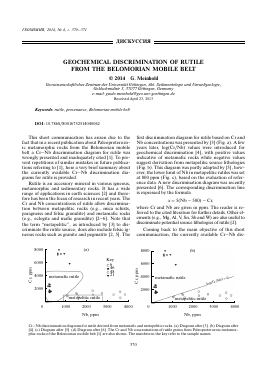TEOXHMHa, 2014, № 4, c. 370-371
= ^HCKyCCHfl
GEOCHEMICAL DISCRIMINATION OF RUTILE FROM THE BELOMORIAN MOBILE BELT © 2014 G. Meinhold
Geowissenschaftliches Zentrum der Universität Göttingen, Abt. Sedimentologie und Umweltgeologie, Goldschmidtstr 3, 37077Göttingen, Germany e-mail: guido.meinhold@geo.uni-goettingen.de Received April 23, 2013
Keywords: rutile, provenance, Belomorian mobile belt
DOI: 10.7868/S0016752514040062
This short communication has arisen due to the fact that in a recent publication about Paleoproterozo-ic metamorphic rocks from the Belomorian mobile belt a Cr—Nb discrimination diagram for rutile was wrongly presented and inadequately cited [1]. To prevent repetitions of similar mistakes in future publications referring to [1], here a very brief summary about the currently available Cr—Nb discrimination diagrams for rutile is provided.
Rutile is an accessory mineral in various igneous, metamorphic and sedimentary rocks. It has a wide range of applications in earth sciences [2] and therefore has been the focus of research in recent years. The Cr and Nb concentrations of rutile allow discrimination between metapelitic rocks (e.g., mica schists, paragneiss and felsic granulite) and metamafic rocks (e.g., eclogite and mafic granulite) [2—6]. Note that the term "metapelitic", as introduced by [3] to discriminate the rutile source, does also include felsic igneous rocks such as granite and pegmatite [2, 5]. The
first discrimination diagram for rutile based on Cr and Nb concentrations was presented by [3] (Fig. a). A few years later, log(Cr/Nb) values were introduced for geochemical discrimination [4], with positive values indicative of metamafic rocks while negative values suggest derivation from metapelitic source lithologies (Fig. b). This diagram was partly adapted by [5], however, the lower limit of Nb in metapelitic rutiles was set at 800 ppm (Fig. c), based on the evaluation of reference data. A new discrimination diagram was recently presented [6]. The corresponding discrimination line is expressed by the formula
x = 5(Nb - 500) - Cr,
where Cr and Nb are given in ppm. The reader is referred to the cited literature for further details. Other elements (e.g., Mg, Al, V Sn, Sb and W) are also useful to discriminate potential source lithologies of rutile [2].
Coming back to the main objective of this short communication, the currently available Cr-Nb dis-
Nb, ppm Nb, ppm
Cr-Nb discrimination diagrams for rutile derived from metamafic and metapelitic rocks. (a) Diagram after [3]. (b) Diagram after [4]. (c) Diagram after [5]. (d) Diagram after [6]. The Cr and Nb concentrations of rutile grains from Paleoproterozoic metamorphic rocks of the Belomorian mobile belt [1] are also shown. The numbers in the key refer to the sample names.
GEOCHEMICAL DISCRIMINATION OF RUTILE
371
£ &
ft
s-T
U
8000 (c) í T T 8000 (d)
T / ?TT /
6000 - 6000 metamafic rutile ▼ /
m p p /
4000 - 4000 - /
2000 4 " ¥ metamafic rutile metapelitic rutile □ n a ° a r^5 □ □ r Cr 2000 metapelitic rutile ~ ¥ / a / „ o n 0 □ □ □
S2- i i i i 4E8-L-1-1-
1000 2000 3000 Nb, ppm
4000
1000 2000 Nb, ppm
3000
4000
Figure (Contd.)
0
0
crimination diagrams for rutile are shown in the Figure together with the rutile chemical data from Pale-oproterozoic metamorphic rocks of the Belomorian mobile belt [1]. Using the most recent diagrams [5, 6] rutiles from the Shuretskoe garnet deposit (sample 6) plot in the field for metapelitic rocks whereas rutiles from the Salma eclogites (samples 46, 48 and 21) plot in the field for metamafic rocks. Hence, the rutiles are correctly classified. Further details about the samples are given in [1].
REFERENCES
1. Skublov S.G., Zack T. and Berezin A.V. et al. "In Situ LA—ICP—MS Investigation of the Geochemistry and U—Pb Age of Rutile from the Rocks of the Belomorian Mobile Belt"// Geochem. Int. 2013. V 51. P. 164-171.
2. Meinhold G., "Rutile and its applications in earth sciences"// Earth-Sci. Rev. 2010. V. 102. P. 1-28.
3. Zack T, von Eynatten H. and Kronz A. "Rutile geochemistry and its potential use in quantitative provenance studies" // Sediment. Geol. 2004. V 171. P. 37-58.
4. Triebold S, von Eynatten H., Luvizotto G.L. and Zack T. "Deducing source rock lithology from detrital rutile geochemistry: An example from the Erzgebirge, Germany" // Chem. Geol. 2007. V. 244. P. 421-436.
5. Meinhold G., Anders B., Kostopoulos D. and Reis-chmann T. "Rutile chemistry and thermometry as provenance indicator: An example from Chios Island, Greece"// Sediment. Geol. 2008. V. 203. P. 98-111.
6. Triebold S., von Eynatten H. and Zack T. "A recipe for the use of rutile in sedimentary provenance analysis" // Sediment. Geol. 2012. V. 282. P. 268-275.
rEOXHMHH № 4 2014 6*
Для дальнейшего прочтения статьи необходимо приобрести полный текст. Статьи высылаются в формате PDF на указанную при оплате почту. Время доставки составляет менее 10 минут. Стоимость одной статьи — 150 рублей.
